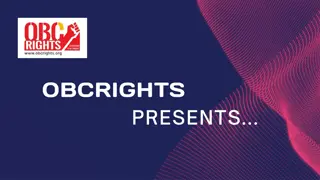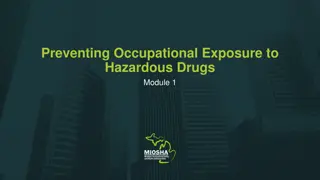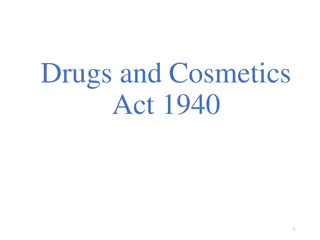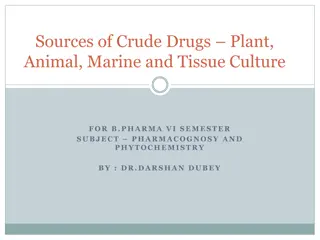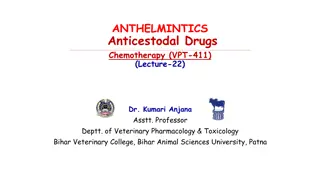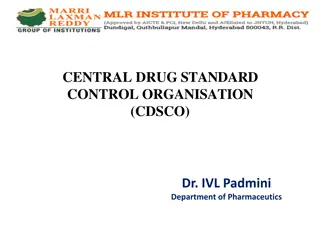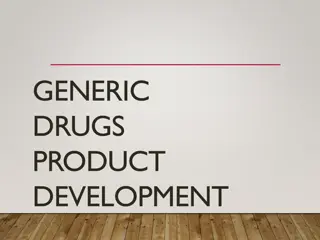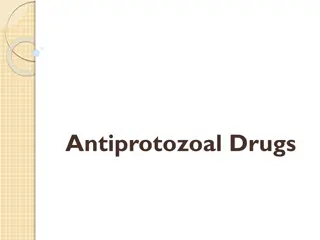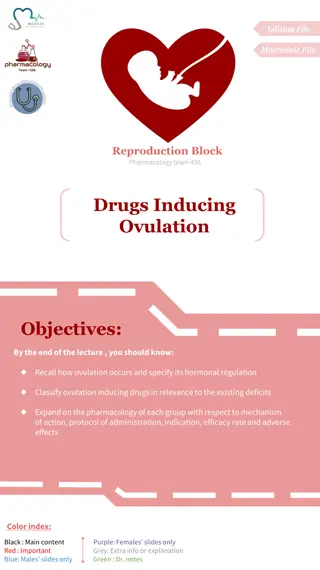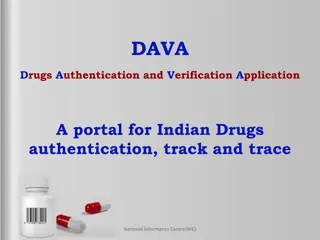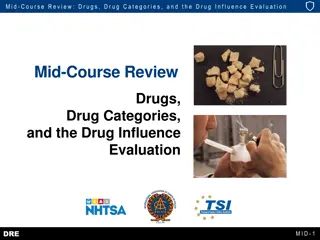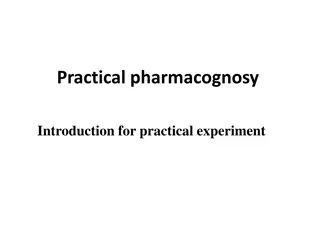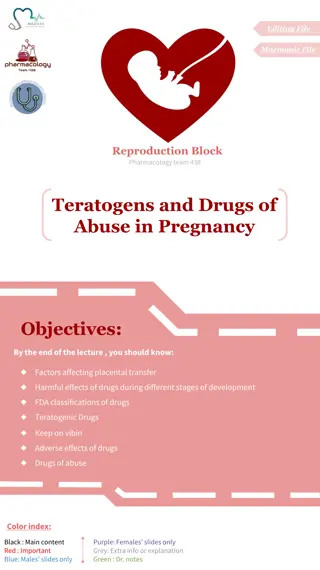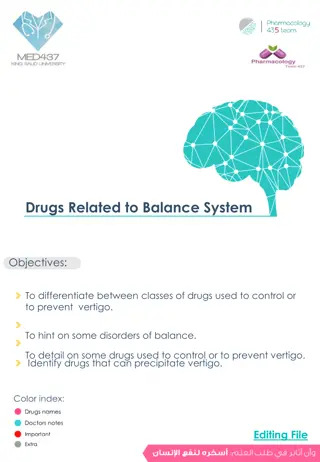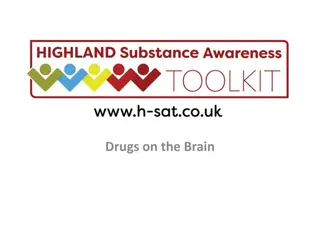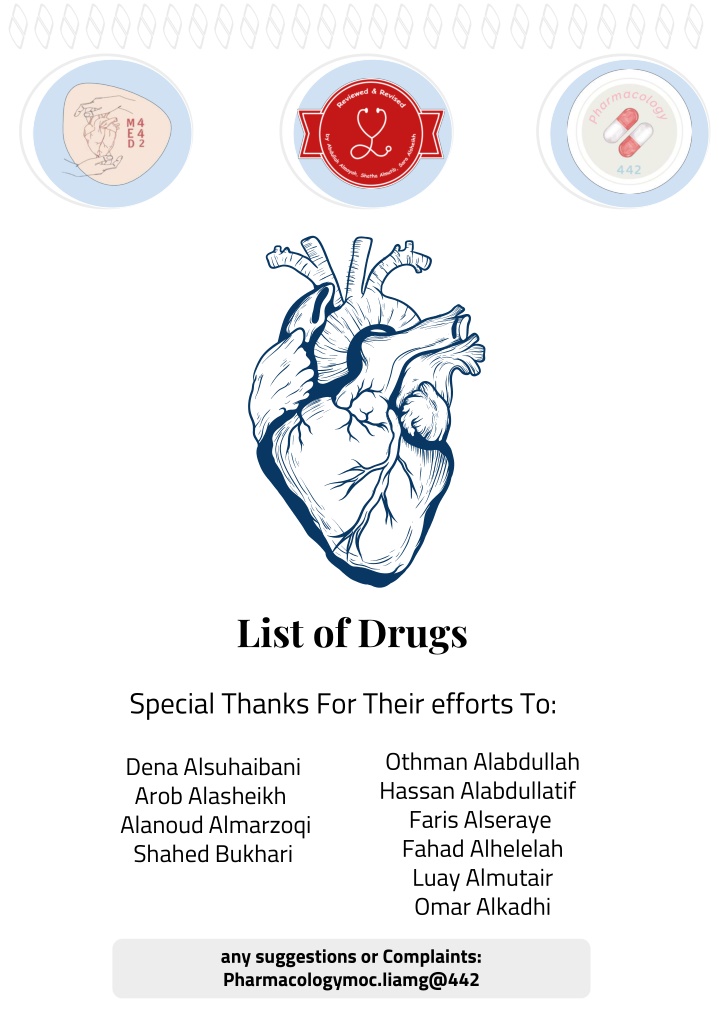
List of Drugs: Adrenergic Neuron Blockers and Adrenergic Blockers Group Overview
Explore the uses, mechanisms of action, and adverse effects of adrenergic neuron blockers and adrenergic blockers. Learn about drugs like Guanethidine, Reserpine, Prazosin, and more. Understand their role in treating conditions such as hypertension, glaucoma, erectile dysfunction, and benign prostatic hyperplasia. Discover common side effects and contraindications associated with these medications.
Download Presentation

Please find below an Image/Link to download the presentation.
The content on the website is provided AS IS for your information and personal use only. It may not be sold, licensed, or shared on other websites without obtaining consent from the author. If you encounter any issues during the download, it is possible that the publisher has removed the file from their server.
You are allowed to download the files provided on this website for personal or commercial use, subject to the condition that they are used lawfully. All files are the property of their respective owners.
The content on the website is provided AS IS for your information and personal use only. It may not be sold, licensed, or shared on other websites without obtaining consent from the author.
E N D
Presentation Transcript
List of Drugs Special Thanks For Their efforts To: Othman Alabdullah Hassan Alabdullatif Faris Alseraye Fahad Alhelelah Luay Almutair Omar Alkadhi Dena Alsuhaibani Arob Alasheikh Alanoud Almarzoqi Shahed Bukhari any suggestions or Complaints: Pharmacology moc.liamg@ 442
Important note: We made this file based on the drugs groups. We collected the repeated uses of drugs that mentioned in more than one lecture under the title of the drug group. To be a good summary of each medicine and the diseases it treats. ) (
scitylohtapmys & srekcolb cigrenerda - Drug MOA Uses Adverse effect Adrenergic neuron blocker: GMC CAR -Inhibition of release and enhance uptake. are drugs that prevent the release of noradrenaline from adrenergic - Guanethidine nerve ending, thus preventing its interaction with the adrenergic - -Formation of false transmitter -Stimulation of presynaptic 2 receptors inhibit NE. -Anti-hypertensive in pregnancy. -Pre-eclampsia. - apod lyhte m - Rebound hypertension upon abrupt withdrawal -Little used as Anti- hypertensive detacilpmoc esaesid laner ybbecause Clonidine -Stimulation of presynaptic 2 receptors inhibit NE. -Open angle glaucoma (eye drops) aqueous humor formation. - Apraclonidine receptors. -Interferse with NA storage. - - Reserpine -irreversibleblock in both 2 receptors (long action 24h) -long name ->long action- -Covalent bonds with receptors NONSELECTIVE -Greater affinity for 1 . & 1 -Postural hypotension -Reflex Tachycardia -Nasal stuffiness/ congestion -Vertigo &drowsiness -Male sexual dysfunction (inhibits ejaculation.) Phenoxybenzamine -Pheochromocytoma (before surgical removal) -Hypertension -Peripheralvascular disease: Raynaud's disease Nonselective -Reversibleblocking of receptors (short action 4h) Short name->Shortaction. 2 & 1 are drugs that prevent the interaction of NA, A and Phenoxybenzamine #conraindicated: -Coronary perfusion -Arrhythmia &angina Phentolamine other sympathomimetics with the receptors -Selective 1 antagonist (short half life) . Heart Failure - both afterload &preload. Anti-hypertensive Prazosin &Doxazosin -Block - receptors in arterioles and venules. -Reduce blood pressure by decreasing both afterload & preload. -Decrease arterial pressure -Less reflex tachycardia -First dose effect: Orthostatic hypotensive response Syncope (taken at night) -Urinary obstruction from benign prostate hypertrophy -Hypertension with prostate enlargement -Raynaud s disease Prazosin selective Adrenergic receptor blocker : 1 Doxazosin -Selective 1 antagonist (long half life) Terazosin -Benign prostatic hypertrophy -Selective 1A antagonist (in prostate) -Non selective Tamsulosin 2 selective 2 NO in corpus cavernosum vasodilation - selective antagonist - -Aphrodisiac in treatment of erectile dysfunction - Yohimbine
? ?adrenergic Blockers Group Drug Uses ADRs due to effect on ? Bronchoconstriction Coldextremities Coronary spasm Erectile dysfunction Hypoglycemia Intermittent claudication (limping) 2 : Timolol (Time for eye drops) Chronic Glaucoma )spord eye( secretionof aqueous humor by ciliary body Non-Selective ?antagonist IOP (Intraocular pressure) Anxiety hyperthyro idism MI migraine Propranolol membrane stabilizingeffect Anti- arrhythmic class ll *Atrial arrhythmia associated with emotions . *WPW. *Digitalis induced arrhythmias. Anti- hypertensive add-on therapy. Lipophilic Metoprolol (can be used in Angina chronic stable type) - ? - 1 due to effect on ? 1 : Hypotension antagonist Selective Heart Failure (NOT acute) Nebivolol - Heartfailure Bradycardia or heart block ends with lolNOT olol Carvedilol Antioxidantaction - due to effect on 1 : Orthostatic hypotension Edema Mask hypoglycemic symptoms (tachycardia, sweating) ? ? - ) Mixed ( Labetalol enarbmem stabilizing effect Hypertensive crisis (e.g. during abrupt withdrawal of clonidine). Pregnancy-induced hypertension ISA & Heart Failure (NOT acute) Angina chronic stable type Bisoprolol - antagonist Hydrophilic Anti- Anti- Angina chronic stable type ? - 1 arrhythmic class ll *Atrial arrhythmia associated with emotions . *WPW. *Digitalis induced arrhythmias. hypertensiv eadd-on therapy . - Atenolol Selective specific Use: Given I.V. for rapid control of ventricular rate in patients With atrial flutter or fibrillation Esmolol T - = 10min Precautions M.O.A Contraindications Anti-arrhythmic Bronchial Asthma (give cardio-selective -blockers) automaticity of S.A. node & ectopic pacemakers refractory period ( conduction) of the A.V node Withdrawn gradually to prevent withdrawal syndrome: rebound angina, arrhythmia, myocardial infarction & hypertension Diabetic patients Masking of hypoglycemia GIVEN CAUTIOUSLY Heart Failure Alonein pheochromocytoma eb TSUM( htiw nevig cardiac remodeling heart rate = allows LV time to refill renin release mortality & morbidity of patients with HF ) srekcolb due to up-regulation of - receptors Heart Block: traehblock due to bradycardia etatipicerp nac srekcolb - Peripheral vascular disease e.g.Raynaud's (give cardioselective 1 blockers) Anti-hypertensive CO renin release
Other Drugs for HF Aldosterone Antagonist Drug MOA Uses Decreases preload -Improves survival in advanced heart failure -Drug of choice in patients with hypokalemia -Potassium sparingdiuretic(no hypokalemia ) -Nonselective antagonist of aldosterone receptor (inhibits hormones ) Spironolactone Decreases preload -Improves survival of stable patients with congestive heart failure -Selective aldosteronereceptor antagonist (does not inhibit other hormones; estrogen & androgen) Eplerenone New Drugs for Heart Failure Class Drug MOA Use cGMP in vascular smooth muscle leading to : -smoothmuscle relaxation (vasodilation). -reduction of preload and afterload. - treatment of patients with ADHF who have dyspnea at rest or with minimal activity Natriuretic Peptides Nesiritide -Calcium sensitization (improves cardiac contractility Withoutincreasing oxygen consumption). -Potassium-ATP channelopening cause : 1 2 management of ADHF (ADHF acute decompensated heart failure ) Calcium sensitisers Levosimendan - vasodilation - improving blood flow to vital organs.)
Calcium Channel Blockers (CCBs) Classificatio n Dihydropyridines Phenylalkylamines Benzothiazepines Nifedipine Drug Verapamil Diltiazem (Amlodipine Nicardipine) Intermediate effect act on both myocardium and smooth muscle Cardiomyocytes Selectivity Vascular smoothmuscle (no need to combine with ) srekcolb - bind to L-type Ca+channels block influx of Ca+ peripheral vasodilation OR cardiac contractility (according to each drug s selectivity) Anti-arrhythmic : Slow conduction Prolong effective refractory period (ERP) M.O.A reflex tachycardia less effect on myocardium constipation - peripheral edema (ankle edema) they dilate arterioles NOT venules blood accumulate in arterioles & capillaries leaking fluid in the surrounding tissue Edema common ADR ADRs - Headache, Flushing, Hypotension Chronic hypertension Anti-arrhythmic Class IV - Atrial arrhythmias, NOT ni evitceffeventricular arrhythmias Variant first choice Uses Attacks completely prevented in 70%of patients treated with nitrates &CCBS Angina Stable: regular prophylaxis Unstable: Seldom added in refractory cases
Diuretics Class Thiazides Loop Diuretics Potassium-Sparing Chlorothiazide (chlorthalidone) Drug Furosemide (lasix) Spironolactone Features Mildciteruid Potentciteruid minimal effect on lowering BP immediately severe pulmonary congestion& edema associated with: Acute heart failure Moderate & severe chronic Heart Failure First-line agent in Heart Failure therapy - mildevitsegnoc eruliaf traeh Hypertensive stneitap with renal impairment Uses Adequate in mild to moderate Hypertension very useful Anti HT drugs and should be the initial treatment of HT - sgurd TH tnetop yrev ton - Heart Failure: salt and water retention size Improvement of cardiac performance ventricular preload and venous pressure cardiac M.O.A Hypertension : salt and water retention Blood volume CO BP chlorthalidone - 1 ahpla na dna rekcolb lennahc muiclac a ,rotibihni ECA na ot tneve ralucsavoidrac erom ro eno gnitneverp roirepus si )citeruid eciohc tsrif( ALLHAT Trial ni tsinogatna cigrenerda Hyperkalemia Hypokalemia (K sparingdiuretics level of potassium ) (K losingdiuretics level of potassium) Contra- indications Gout (diuretics excretion of uric acid)
Drugs that increase contractility Cardiac glycosides (digitalis) Digoxin : 1 - have narrow therapeutic index. 2 - excreted by kidney. 3 - long Half life. Drug Digoxin - Inhibits Na+ / K+ ATPase enzyme (the sodium pump) -Increases the force of myocardial contraction +(ve inotropic effect) 1 M.O.A Uses -Congestive heart failure ONLY if patient has decrease in contractility .) 438 ( Cardiac : digitalis-induced arrhythmias: - Extrasystoles . -Coupled beats (Bigeminal rhythm .) -Ventricular tachycardia or fibrillation. -Cardiac arrest Non-cardiac: - GIT anorexia (loss of appetite), nausea, vomiting, diarrhea -CNS: headache, visual disturbances, drowsiness. ADRs Factors that Increase its toxicity . - 2 . Electrolyte disturbances: Hypokalemia - Hypomagnesemia - Hypercalcemia 1 Renal diseases tsinogA rotpeceronerdA - Dobutamine Drug M.O.A Selective 1 agonist. Uses Treatment of acute heart failure in cardiogenic shock Phosphodiesterase-III inhibitors Enoximone Vesnarinone Drug Milrinone Inhibit phosphodiesterase -III (cardiac & B.vessels) cAMP. increases cardiaccontractility . dilatation of arteries & veins (reduction of preload& afterload.) M.O.A -Used only IV for management of acute heart failure. - Not safe for effective in the longer ( >48hours) treatment of patients with heart failure. Uses New drugs in clinical trials. -Hypotension and chest pain (angina) ti os ( more than 2 days ) s not use at ADRs - -Furosemide (Diuretic drug) shouldn t be administered in IV lines containing milrinone due to formation of a precipitate. ( It affects their absorption because they are not in their dissolved form) Chemical interactio ns -
Anti-Arrhythmic drugs Class I Na+ channel blocker (membrane stabilizing drugs) ADRs Subclass Drug MOA Use - Quinidine syncope: ot eud gnitniaf fo sedosipe gnitsiwt( setniop ed sedasrot ta gnipoleved )sekips eht fo therapeutic plasma levels . 2 effects: Dry mouth, blurred vision, urinary retention constipation. 3 gnisserpedcontractility& vasodilation. 1 -anticholinergic effects: noticudnoc esaercni through AV node (risk of ventricular tachycardia ) gnikcolb cigrenerda effect cause: 1 - vasodilation 2 - reflex tachycardia -ECG changes: 1 - Prolong P-R & Q-T interval 2 - Widens QRS complex 1 - Atrial flutter & fibrillation . - - - Anticholinergic adverse Quinidine 2 - Maintaining sinus rhythm after cardioversion. - Hypotension: ot euD Ia (Prolong the action potential duration) - Torsades de pointes ta( . - In long term therapy, it 1 )esod cixot 2 causes reversible lupus erythematosus like syndrome. 3 4 Similar to Quinidine except: 1 2 Ventricular than in atrial arrhythmia. 3 - blocking actions. - Less toxicon the heart - More effective in More effective in Ventricularthan in atrial arrhythmia. Procainamide - Less anticholinergic or - Hypotension - Hallucination &psychosis. Treatment of emergency ventricular arrhythmias: yregrus gnirud 2 myocardial infarction - Hypotension - CNS ADRs rehto ot ralimis( - aisehtseraP airhtrasyD 1 2 )scitehtsena lacol - sutinniT Confusion -Convulsion . - following acute - 1 Lidocaine romerT - - Ib - Not effective in atrial arrhythmias Na+ channel blocker (Shorten the action potential duration) - Nausea, vomiting - tremor, drowsiness, diplopia elbuod(vision .) 3 hypotension. 1 2 - ventricular arrhythmia 2 arrhythmias 1 Mexiletine - Digitalis induced - arrhythmias & - Supraventricular arrhythmias. 2 resistant. arrhythmias. 3 ventricular arrhythmias, but very high risk of proarrhythmia. 4 syndrome(WPW). 1 - Proarrhythmia . - CNS : dizziness , tremor, blurred vision, abnormal taste sensations, paraesthesia . 3 inotropic effect. 1 2 Ic - Should be reserved for Block the influx of Na Ions ( markedlyslow phase 0 depolarization) ( No effect on action potential duration) - Very effective in Flecainide - Heart failure due to (-ve) - Wolff Parkinson White
Anti-Arrhythmic drugs Class III (K+ channel blockers) Drug MOA Use ADR interactions - Exacerbation of ventricular arrhythmias. 2 failure. 3 necrosis. 4 containing iodine. 5 deposits. (Should avoid the sun) 6 7 constipation. 8 Hepatocellular necrosis. 1 - Co-administration fo taht sgurd htiw enoradoima lavretni TQ eht gnolorp sedasroT fo ksir eht sesaercni setnioP ed 2 inhibit CYP3A enzymes cause increase in serum concentration of amiodarone. (e.g. Loratadine, Ritonavir (AIDS/HIV drug), Trazodone (antidepressant), Cimetidine, Grapefruit juice .) 3 enzymes ni esaerced esuaC fo noitartnecnoc mures enoradoima 1 Mainly cause : 1 and prolong refractory period. 2 repolarization. additional effects : -Class lA, II, IV. -Vasodilating effects. Pharmacokinetic 1 2 CYP2C 8 metabolite;N-desethylamiodarone. 3 hepatic metabolism. 4 appear in breast milk. - prolong AP duration - Bradycardia and heart - Pulmonary fibrosis & . - Drugs (or substances) that 2 - Main use: serious resistant ventricular arrhythmias . 2 rhythm after D.C. cardioversion . 3 arrhythmias e.g. WPW. 1 - Prolong phase 3 - Hyper or hypothyroidism PYC & 4 C8 - Maintenance of sinus - Photodermatitis & skin Amiodarone - Resistant supraventricular - Neurological (e.g. tremors.) - Nausea, vomiting and - long half-life( - Metabolized by (CYP3A4 and .) Toits major active 103 - 13 DAYS.) - Drugs that induce these - Corneal micro deposits and - Eliminated primarily by ( e.g. Rifampin.) - Can cross placenta, and - Prolong noitcA eht . - Prolong 1 PR & noitarud laitnetop 2 repolarization . -Causes QT interval prolongation (phase 3 ) . Used for acute conversion of atrial flutter or fibrillation to normal sinus rhythm. Ibutilide )III ssalC erup( by I.V infusion May cause Torsades De pointes. 3 esahp - Class V Drug MOA Use ADR Inhibit cAMP by binding to adenosine A1 receptors causing the following actions: 1 (Hyperpolarization ) 2 ,mainly at AV node (Negative dromotropic effect ) 3 action potential at SA node (Negative chronotropic effect) - Flushing (in about 20%of patients) vasodilation of superficial vessels 2 burning (in 10%of patients) due to bronchospasm 3 )Contraindicated in heart block) 1 -Drug of choice etuca rof lamsyxorap fo tnemeganam aidracyhcat ralucirtnevarpus -preferred oververapamil (because it s safer and does not depress contractility) - Opening of potassium channels Adenosine suoenallecsiM( Antiarrhythmic Drugs) - Shortnessof breath & chest - Decreasing conduction velocity - Brief A.V block - Inhibiting phase 4 pacemaker New Anti-Arrhythmic Drugs interactions -warning- Drug Overview Pharmacological action Use Used for maintenance of sinus rhythm following cardioversion in patients with atrial flutter or fibrillation traeh )VI ssalc( eruliaf permanent atrial fibrillation. A non-iodinated congener of Amiodarone It has antiarrhythmic properties belonging to all four classes Dronedarone . Drug Use Used in sinus bradycardiakcolb traeh ni dna noitcrafni laidracoym retfa In emergency heart block isoprenaline may be combined with atropine ( caution ) due to its additive effects Atropine
Thrombolytic Drugs (Non Fibrin Specific Thrombolytic Drugs) Drug Streptokinase Antistreplase (APSAC) Urokinase -Is a bacterial protein produced by B-hemolytic streptococci. -It acts indirectly yb negonimsalp gnimrof xelpmoc esanikotperts M.O.A Activator Complex which converts inactive plasminogen into active plasmin. -Can degrade fibrin clots as well as fibrinogen dna rehtoplasma protein. ( APSAC:) An Isolated Plasminogen Streptokinase Activator Complex is an acylated plasminogen combined with streptokinase. -It is a prodrug, de-acylated in circulation into active plasminogen- streptokinase complex. (direct) - -Human enzyme synthesized by the kidney. -Obtained from either urine or cultures of human embryonic kidney cells. -Is a direct plasminogen activator. - MOA -Least expensive. -Used for venous and arterial sisobmorht -Longer duration of action than streptokinase . -More thrombolyticactivity. -Greater clot selectivity. -Used for the lyses of acute massive pulmonary emboli. -No anaphylaxis (not antigenic.) . Advantages 1 poleved seidobitna weeks after use, precluding retreatment until the titer declines. 2 ,sehsarfever, hypotension. 3 gnitalucric fo noitavitca negonimsalp fibrinolysis.) 4 - Antigenicity 1 retit - hgih : to 2 Similar but less than streptokinase alone in: -Antigenicity. -Allergic reactions. -Minimal fibrin specificity. -Systemic lysis/hemorrhage. -Expensive than streptokinase. -Minimal fibrin specificity -Systemic lysis (acts upon fibrin- bound and circulating plasminogen.) -Expensive (its use is now limited.) - Allergic reaction ekil : Disadvantages & Side effect - Bleeding ot eud ( systemic - Not fibrin specific. Not used in patients with: -Recent streptococcal infections. -Previous administration of the drug . *These patients may develop fever, allergic reactions and resistance upon treatment with streptokinase due to anti streptococcal antibodies. Precautions -
Thrombolytic Drugs (Fibrin Specific Thrombolytic Drugs) Tissue Plasminogen Activators (t-PAs) Alteplase Reteplase Tenecteplase Drug -All are recombinant human tissue plasminogen (t-PAs). -Prepared by recombinant DNA technology. Directly act by: -They activate fibrin-bound plasminogen negonimsalp eerf naht rehtar in blood. -Their action is enhanced by the presence of fibrin. -They bound to fibrin in a thrombus and convert the entapped plasminogen to plasmin followed by activated local fibrinolysis with detimil systemic fibrinolysis. MOA . Fibrin-specific drugs (clot specific). . Limited systemic fibrinolysis. . Reduced risk of bleeding . Not-antigenic (can be used in patients with recent streptococcal infections or antistreptococcal antibodies) 1 2 3 4 Advantages Specificity - Has enhanced fibrin specificity It s more fibrin specific -In ST-elevation myocardial infarction (STEMI). -Pulmonary embolism. It s only approved for use in acute myocardial infarction. Uses Fibrinolytic Inhibitors (Antiplasmin) : Aminocaproic Acid & Tranexamic Acid Aprotinin Drug Acts by competitive inhibition of plasminogen activation It inhibits fibrinolysis by blocking the action of plasmin MOA ) tsinogatna nimsalp ( Administration Orally Orally or I.V -Fibrinolytic therapy induced bleeding (antidote). -Post surgical bleeding. -Adjuvant therapy in hemophilia. -These drugs work like antidote for fibrinolytic drugs. Similar to protamine (antidote of anticoagulant, heparin) or vitamin K (antidote of oral anticoagulant, warfarin.) Uses
Drugs For Hyperlipidemia That Act Exogenously Bile Acid Sequestrants/Resins Drug Cholestyramine Colestipol Colesevelam - Binds to bile acid debrosbaer eb tonnac taht .xelpmoc elbulosni morf & enitsetni llams ni - The liverincreases the number of LDL receptors to obtain more cholesterol and to convert it to bile salts, thus, the levels of LDL in the serum are reduced. Second -GIT upset: Abdominal discomfort, bleeding, bloating, constipation. - Decreased absorption of fat Biliary obstruction, chronic constipationsoluble vitamins )A, D, K ) . 1 . MOA 2 aimeloretselohcrepyh rof ypareht enil - Uses ARDs Contraindication Biliary obstruction, chronic constipation, Hypertriglyceridemia (TG>400mg/dL) Interfere with the absorption of many drugs )nirafraw& ,nixogid, sedizaihtorolhc ,ebimiteze ,snitatS ( Therefore, otherdrugs should be taken 1 hour before, or 4 hours after taking resins. Except colesevelam fo noitprosba eht htiw erefretni ot nwohs neeb ton sah ti ,other drugs. Cholesterol Absorption Inhibitors Ezetimibe Inhibits intestinal cholesterol absorption by inhibiting Niemann-Pick C Delivery of dietary cholesterol to the liver Upregulationof LDL receptor Trapping more LDL particles from blood. Resulting in total cholesterol and LDL with minimal effects on HDL and triglycerides. . Drug interaction Drug 1 CPN( 1 ekil - 1 L rotpecer ) 1 MOA Uses Hypercholesterolemia. Usually used in conjunction with statin (synergistic effect) ARDs Not common but may occur: GIT disturbance, headache, fatigue, arthralgia and myalgia. Drugs For Hyperlipidemia That Act Endogenously Drug Niacin (Nicotinic Acid) Water soluble B-complex vitamin with multiple actions In adipose tissue: mobilization from adipocytes to the liver In liver: Niacin inhibits hepatocyte it VLDL production ( TG synthesis and esterification .) In plasma: LDLV fo ecnaraelc sesaercni taht ytivitca )LPL( esapil nietorpopiL sesaercni tI srotpecer dica cinitocin setycopida ot sdnib tI decrease in free fatty acids TG and thus VLDL. acyltransferasea key enzyme for TG synthesis. Thus MOA lorecylglycaid - 2 & chylomicrons VLDL by : synthesis in liver, clearance in plasma, mobilization of free fatty acids from adipose tissue. LDL by HDL by 2 Pharmaco- Logical Action sti fo noitcuder ot eud .lacigol precursor (VLDL). : : - 1 Induces modest increase in HDL-C - Niacin also promotes hepatic apoA-I production and slows hepatic clearance of apoA-I and HDL . Monotherapy or in combination with fibrate, resin or statin -It is useful for patients with mixed dyslipidemias. -Niacin exerts greatest beneficial effects on wide range of lipoprotein abnormalities. -Type IIa hypercholesterolemia. Type IIa, IIb hypercholesterolemia & any combined hyperlipidemia . Patient with hypertriglyceridemia & low HDL-C. (most effective medication for HDL) Uses -Flushing nicain erofeb ruoh niripsa esod wol yb dediova eb nac )detaidem nidnalgatsorp si hcihw ( - -GI distress:Dyspepsia, nausea, reactivation of peptic ulcer ( can be if taken after meal.) -Reversible in liver enzymes hepatotoxicity . -Impairment of glucose tolerance Over diabetes. - . snoitaraperp esaeler deniatsus gnisu dna ARDs Uric acid Gout. Contraindication -Gout. - Peptic ulcer. - Hepatotoxicity. - Diabetes mellitus (used with caution.)
Drugs For Hyperlipidemia That Act Endogenously Fibrates Statins (Fibric Acid Derivatives) ( Rosuvastatin, Atorvastatin, Lovastatin, Pravastatin, Simvastatin, Fluvastatin) Drug Clofibrate Gemfibrozil Fenofibrate Binds to and activates nuclear peroxisome proliferator activated receptor-(PPAR (, expressed primarily in the liver and skeletal muscle. These receptors increase gene transcription of lipoprotein lipase (LPL) desaercni ot gnidael LDLV ni GT fo msilobatacand chylomicrons. They cause: *A marked reduction in TG (due to catabolism of VLDL.) * * * * hepatic C synthesis may be decreased. HMG-CoA reductase inhibitor. Blocks endogenous cholesterol synthesis, forcing hepatocytes to LDL receptors extraction (VLDL remnants) from the circulation. Results in large in total cholesterol and LDL, medium in triglycerides, and small in HDL. Hepatic LDL catabolism and LDL precursor MOA FFA uptake by the liver. LDL-C uptake by the liver. HDL by apoA-I and apoA-II expression. Excretion of hepatic C in bile, thus endogenous Results in large in triglycerides, medium in HDL, and small in total cholesterol and LDL. PO. Metabolized by CYP3A neewteb lamixam si sisehtnys C citapeh midnight& 2:00am. Except atorvastatin taken at any time because of its long T esuaceb emitdeb ta nekaT . 4 - P.K 12 ( hrs.) -Hypertriglyceridemia 1st-line defense for: -Mixed dyslipidemia (i.e. raised serum TG and C.) -Low HDL levels. (improves clinical outcomes in patients with coronary disease and low HDL levels). -Patients with resistant dyslipidemia. 1 st-line therapy LDL & aimeloretselohcrepyh ecuder ot yretra yranoroc htiw ro rof ksir ta stneitap ni slevel esaesid -Used in diabetics and patients with insulin resistance. -Reduces cardiovascular mortality and risk of myocardial infarction, and stroke. - . Uses -Common side effects: headache, myalgia, fatigue, GI intolerance and flu-like symptoms. -Hepatotoxicity concentration of serum aminotransferases. -Myopathy -Teratogenicity ARDs GI distress, rash, myopathy, gallstones. . ]KC[ -Pregnancy -Liver disease -Severe hepatic or renal dysfunction. -Pregnantor nursing women. contraind- ication -Fibrates( risk of myopathy). -Drugs metabolized by 3A4isoform of cytochrome P450 like: Erythromycin, verapamil, cyclosporine, ketoconazole. Except pravastatin &fluvastatin fo nitats eht era eseht , yb dezilobatem sgurd rehto gniklat stneitap ni eciohc CYP3A4system. -Increased risk of myopathies when used with statins (they metabolism of statins, so must be given in low doses) -Potentiates effects if anticoagulant like warfarin & oral hypoglycemic drugs (because they displace drugs from plasma proteins (oral). Drug interactions
Anti-Anginal Drugs (New Approaches) - Potassium Channel Openers 1 Nicorandil Drug . Opening of KATP channels 1 . Acting as NO donor 2 On VSMCs: K channels opening Hyperpolarization Vasodilation (improves coronary blood flow) On VSMCs: NO donner cGMP/PKG P.D Vasodilation Dual action mechanism On cardiomyocyte: K channels opening repolarization Cardiac work . Prophylactic 2nd line therapy in stable angina. 2 1 . Refractory(not responding) variant angina. Indications Flushing, headache, hypotension, palpitation due to nitrate effect , weakness, mouth & prei-anal ulcers Dr s note: special ADR for nicroranil, nausea and vomiting. ARDs - Metabolically Acting Agents 2 Trimetazidine Drug P.D During ischemia, metabolism shifts to oxidation of FFA (fatty acids), which provides more energy but requires more O consumption & demand, we can enhance utilization of glucose (less O requirement) by giving partial FFA oxidation inhibitors (e.g. Trimetazidine) Dual action mechanism Used as an add on therapy Indications ARDs GI disturbances -Hypersensitivity reaction -In pregnancy &lactation Contraindications
- Late Na Current Inhibition 3 Ranolazine Drug Inhibits the late sodium current (which opens in phase 4 depolarization), which increases during ischemia and affects Na dependent-Ca channels. Pharmacological action Indications Used in chronic angina concomitantly with other drugs ARDs GIT disturbances -It prolongs the QT interval so contraindicated with class Ia & III antiarrhythmic drugs. -Toxicity develops due to interaction with CYT-P450inhibitors as; diltiazem, verapamil, ketoconazole, macrolide antibodies, grapefruit juice. Precautions - Sinus Node Inhibition 4 Ivabradine Drug -Selectively blocks I(f) [ I(f) current is an inward Na K/ current that activates pacemaker cells of the SA MOA node] Pharmacodynamic effect -Acts of the Funny Channel a special Na channel in SA-node, reduces slope of depolarization, slowing HR, reducing myocardial work & myocardial O demand. -Used in treatment of chronic stable angina in patients with normal sinus rhythm who can t take -blockers. -Used in combination with -blockers in people with heart failure with LVEF lower than 35% inadequately controlled by -blockers alone and whose heart rate exceeds Indication . nim/ 70 ARDs Luminous phenomena
ACEIs Drugs CaptoprilonisiL ,prilalanE ,prilimaR ,pril -Polar -Enalapril& Ramipril are prodrugs ni etuor .V.I yb nevig eb nac ,lirpalanE fo etilobatem evitca eht si talirpalanE , hypertensive emergency. P.K -inhibiting ACE -Particularly effective when hypertension results from excess renin production ( renovascular hypertension, white &young) -Their effect result primarily from vasodilation (reduction of peripheral resistance) with little change in cardiac output -A fall in aldosterone production may also contribute. -Decrease both preload and afterload -decrease sympathetic activity and cardiac and vascular remodling -Treatment of essential hypertension. -Hypertensionin patient with chronic renal disease, ischemic heart disease , diabetes .. -the first line in chronic Heart failure -Dry Cough - Acute renal failure, especially in patients with renal artery stenosis. - Severe hypotension in hypovolemic patients - Renal angensia/ failure in the fetus resulting in oligohydramnios. - Angioneurotic edema accumulate in bronchial mucosa . -First dose effect ADRs effects Specific to captopril : skin rash, fever, dysgeusia ,Proteinuria, and neutropenia. -The second and third trimesters of Pregnancydue to the risk of: fetal hypotension, anuria, renal failure & malformations . -Renal artery stenosis. -Potassium-sparing diuretics . -NSAIDs rieht riapmI( . hypotensive effects) ARBs M.O.A Uses ADRs )xnyral & taorht ,eugnot ,eson fo gnillews( caused by inhibition of bradykinin that Contraindi cations Drugs Losartan(has active metabolite) Valsartan (no active metabolite) Irbesartan -Selective block of AT1 receptors. (decrease action of AT 2 ) -Produce morecomplete inhibition of angiotensin than ACE inhibitors -why?because there are other enzymes (not only ACE) that can generate angiotensin - No effect on bradykinin Decrease both preload and afterload used in: 1 M.O.A - hypertension 2 - Heart failure - ADRs Same as ACEI exceptamedeoigna on ,hguoc on ,ninikydarb no tceffe oN: . Contraind- ications - Same contraindications as ACEI. Direct renin inhibitors Inhibits the first and rate limiting step of the RAAS (used in hypertension) It has been approved for monotherapy or in combination therapy, but usually isn t used as a first line therapy because it s still a new drug Aliskiren
Vasodilators Minoxidil Arteriodilators Opening of potassium channels in smooth muscle membranes by minoxidil sulfate (Active metabolite) Drug Hydralazine Diazoxide Sodium nitroprusside Artiodilator & venodilator Release of nitric oxide (NO) Opening of potassium channels Release of nitric oxide (NO) M.O.A Oral Rapid l.V I.V infusion Administration Moderate-severe hypertension Hypertensive emergency In combination with diuretics & -blockers Hypertensive pregnant woman heart failure reducing PVR when the main symptom is fatigue Treatment hypoglycemia amonilusni oteud - Baldness Therapeutic uses acute or Severe heart failure - - ADRs Severe hypotension Hypotension, reflex tachycardia, palpitation,angina, salt and water retention (edema). -Methemoglobin during infusion - Cyanide toxicity- Thiocyanate toxicity Inhibit insulin release from cells of the pancreas causing hyperglycemia. Contraindicated in diabetics Organic Nitrates Short-acting Nitroglycerin Venodilators Supply of NO activation of protein kinase G smooth muscle relaxation vasodilation decrease Preload 1 2 3 4 Used I.V. for severe heart failure when the main symptom is dyspnea due to pulmonary congestion and edem Sublingual Stable angina Situational prophylaxis Acute symptom relief Variant angina lupus Hypertrichosis excess hair growth Contradicted in females Specific ADRs erythematosus like syndrome Long-actingIsosorbide Mononitrate Drug setartin yb activation of guanylate cyclase in vascular smooth muscle cGMP M.O.A ) Venous noitalid noitalid noitalid preload ) Coronary myocardial perfusion afterload Hemodynamic Effects ) Arterial ) Shunting aera aimehcsi ot aera lamron morf wolf foby dilating collateralslessev IV Stable angina Persistent prophylaxis Congestive HF( with Hydralazine ) When ACEIs are contraindicated Indications Unstable angina Acute symptom relief Refractory AHF ) Sensitivitysetartin cinagro ot 2 3 Intracranial pressure larberec ro amuart daeh .g.e(hemorrhage ) ) PDE 5 inhibitors .g.e(Sildenafil 1 ) Glaucoma Uncorrected hypovolemia Contra- indications ) ) 4 5 setartin htiw ) severe hypotension death Throbbing headache Flushing Postural hypotension (dizziness) reflex tachycardia (palpitations) syncope Rarely: methemoglobinemia Nitrate tolerance: loss of vasodilator response of nitrates on long-term use ADRs

